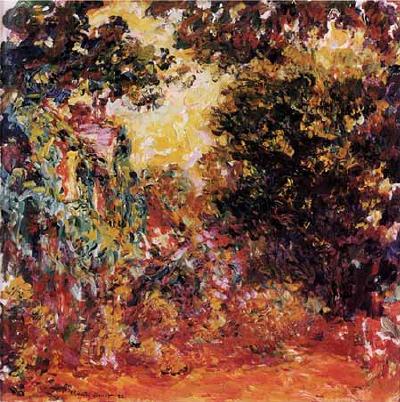
I’m doing an art course. And I need a way to get my essay to class, and posting it here seems to be the easiest way. It’s not very good, I’m afraid. Not being able to be flippant or bizarre seriously stunts my writing ability. Anyway, here it is.
People discuss my art and pretend to understand as if it were necessary to understand, when it’s simply necessary to love. – Claude Monet
Claude Monet was one of the primary initiators of the Impressionist movement. It is true that he was more concerned with colour than with form, but those colours were plucked from what lay before him with skill. He was a great lover of nature, spending many hours in the gardens of Giverny, and Argenteuil. His paintings make us feel like we know those places, and we share in the calmness of a pleasant afternoon spent in the continental sunshine. By sharing not only the view, but also the feeling, Monet gets closer to the ideals of naturalism than a painter who religiously copies each and every line and blemish.
He developed a style of brushwork in which he would apply jabs of paint to the canvas, giving his work a wonderful textural quality. By using the texture of the paint itself to add detail, he did not need to copy every line of a leaf in order for our minds to be able to reconstruct the plant. This caused him to use rather more paint than most of his contempories, and indeed his paintings are said to be noticeably heavier than usual. Up close, his work looks far from naturalistic, almost abstractly wild gobs of paint, but should you take a few steps back, those jabs and sworls merge, and, almost magically, the picture forms before you.
Monet mostly painted landscapes, but not the wide, sweeping, landscapes of a Turner or Constable, humbling the viewer with the majesty of nature. Monet’s were more intimate, and usually looked like far more pleasant places to be. Raging storm would have impeded the opportunities for using the rich colours he was so fond of. In fact, it is said that on a rainy day, he would be so upset that he would refuse to get out of bed! Calm waters are a particularly common motif in his work, especially in his later works, paired with water-lillies. (Ironically, he once attempted suicide by throwing himself off a bridge into in a river, but changed his mind on the way down.).
His painting of the Giverny water-lillies are almost the ultimate in naturalism. Placed in a specially constructed building, they provided a 360 degree view of the garden, so the viewer could truly feel as if they were there. An Impressionist virtual reality, perhaps.
Colour is my day-long obsession, joy and torment. To such an extent indeed that one day, finding myself at the deathbed of a woman who had been and still was very dear to me, I caught myself in the act of focusing on her temples and automatically analysing the succession of appropriately graded colours which death was imposing on her motionless face. – Claude Monet
It was about 1905 when Monet began to suffer a loss of intensity in his perception of colour. A cataract has the effect of desaturating colour, and shifting things towards the yellow. Violets, blues and greens are particularly transformed, but every hue is affected to some degree. That different hues are affected to different levels only adds to the strangeness of the view.
While Monet was aware of this gradual change, he was still shocked as to how extent it had become when, upon having surgery on one eye in 1923, he was able to once again percieve colours correctly. He destroyed several of his own works, embarrassed as to how bizarre they appeared to normal vision. He kept his other eye unfixed, and was never again able to use them together terribly well. But one supposes that it did allow him to be able to take two different views of the same subject, which he might have considered useful.
It raises an interesting point. If naturalism is the act of painting what you see, rather than what is actually there, then would someone suffering from wild visual hallucinations be considered naturalistic if he were to paint them?
 “La maison vue du jardin aux roses” Claude Monet (1922) – is one of the last paintings Monet painted before his eye surgery. The muddying of the greens of the plantlife is particularly noticeable. Compared with his earlier work, there is also a pronounced lack of detail. Nevertheless, it is still a beautiful picture, with masterful brushwork , and strong use of colour, however shifted, and whatever the cause.
“La maison vue du jardin aux roses” Claude Monet (1922) – is one of the last paintings Monet painted before his eye surgery. The muddying of the greens of the plantlife is particularly noticeable. Compared with his earlier work, there is also a pronounced lack of detail. Nevertheless, it is still a beautiful picture, with masterful brushwork , and strong use of colour, however shifted, and whatever the cause.
I would advise young artists . . . to paint as they can, as long as they can, without being afraid of painting badly . . . . If their painting doesn’t improve by itself, it means that nothing can be done – and I wouldn’t do anything! – Claude Monet